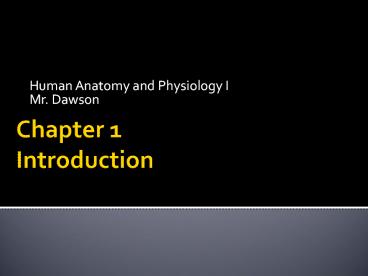Chapter 1 Introduction - PowerPoint PPT Presentation
1 / 29
Title:
Chapter 1 Introduction
Description:
Human Anatomy and Physiology I Mr. Dawson 1. Anatomy and Physiology 2. The Standard Anatomical Position 1. Ventral vs Dorsal 2. Ventral viscera Thoracic Pleural ... – PowerPoint PPT presentation
Number of Views:226
Avg rating:3.0/5.0
Title: Chapter 1 Introduction
1
Chapter 1 Introduction
- Human Anatomy and Physiology I
- Mr. Dawson
2
Introduction
- 1. Anatomy and Physiology
- 2. The Standard Anatomical Position
3
Directional Terms
4
Regional Terms
5
Body Planes
6
Body Cavities
- 1. Ventral vs Dorsal
- 2. Ventral
- viscera
- Thoracic
- Pleural and pericardial cavities
- Abdominopelvic
7
Body Cavities
8
Body Cavities
9
Membrane Coverings
- 1. Serous membrane or Serosa
- Double membrane - fluid
- 2. Covers organs and cavity walls
- Parietal vs visceral
- Parietal pericardium
- Visceral pleura
- Visceral peritoneum (covers abdominal organs)
10
Serous Membrane (Serosa)
11
Heart and Serous Membranes
12
Cavities in the Head
13
Characteristics of the Human Body
- I. Levels of Organization
- II. Life Functions
- III. Systems of the Body
- IV. Survival Needs
- V. Homeostasis
14
Organization of the Human Body
15
Life Functions
- 1. Response to stimuli
- 2. Metabolism
- Anabolic
- To build up energy requiring
- Catabolic
- To break down energy releasing
- 3. Reproduction
- Gametes Sexual
- sperm and egg haploid
- 1-celled zygote
16
What do organisms need to survive?
- 1. Nutrients
- Carbohydrates, lipids, proteins, vitamins,
minerals - 2. Oxygen
- 20 of air
- Cellular respiration (glucose oxygen)
- 3. Water
- 60-80 water
- Cells mostly made of water
- Hydrolysis reactions
- 4. Maintain normal body temperature
- 37 C
17
Body Systems
- Organs work together to accomplish a common
purpose - What should you know about each system?
- 1. Overall or general function
- 2. Examples of organs
18
Body Systems
19
(No Transcript)
20
(No Transcript)
21
(No Transcript)
22
Homeostasis
- 1. Maintain stable internal condition within the
body - 2. Dynamic
- Conditions are maintained within narrow limits
- 3. All organs are involved work together or in
opposition - 4. Examples
- Glucose levels
- Blood Clotting
- Gas levels (oxygen and carbon dioxide)
- pH
23
Control Systems- Homeostasis
24
Feedback Systems
- (1). Negative
- (a). Inverse variable change- to the initial
response - (b). Blood Glucose Control- Endocrine System
- (c). Most common
- (2). Positive
- (a). Direct variable change- in the same
direction as the original change - (b). Self-perpetuating events
- (c). Blood Clotting Labor and Contractions!
(Oxytocin)
25
Negative Feedback System Pancreas (blood glucose
regulation)
26
Antidiurectic Hormone and Water Balance
- 1. Kidneys help to maintain proper water balance
in the body. - 2. Blood low levels of water (hypertension)
- ADH released from posterior pituitary gland
- Causes reabsorption of water into the blood (from
the kidney tubules) - 3. If water volume is too high
- ADH not released ---------? increased urination
27
Kidney Tubules
28
Positive Feedback System
29
Homeostatic Failure
- Homeostatic mechanisms must cope or adapt to
stress - Changes in the environment, introduction of
pathogens, etc. - The failure of one system may affect another
system adversely. - Effect of Disease (failure to maintain
homeostasis) - 1. pathogens 2. genetics 3. abnormal cell
growth due to cancer - 4. degenerative 5. trauma environmental
hazards - 5. nutrition (Scurvy and vitamin C)

